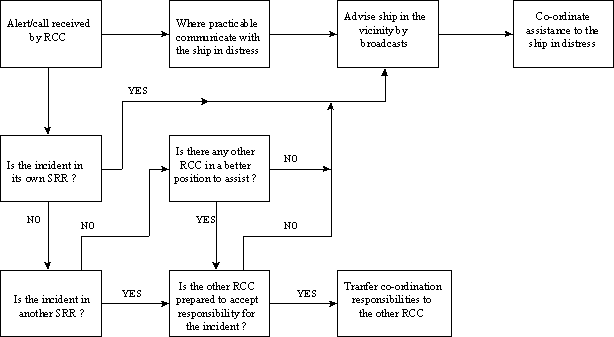| |
| |
 |
GMDSS Handbook
|
 |
|
| |
|
Part - 6 Shore-based SAR communication network and operation
|
| |
6.1 To exploit the full advantages of globally integrated satellite ant terrestrial communications, the GMDSS necessitates establishment of an efficient communication network between RCCs. This will consist of interconnecting links between RCCs in accordance with arrangements made by IMO in support of the 1979 SAR Convention. In addition, each RCC will need rapid and effective communication links with its associated coast stations, INMARSAT CESs and COSPAS-SARSAT MCCs.
6.2 The interconnecting links between RCCs will usually be implemented using the public switched networks or dedicated circuits. Some RCCs, particularly those not having sufficient access to the public switched networks, may use an INMARSAT SES to assist in the rapid exchange of distress and safety information between RCCs (RR N2938 ).
6.3 The communications network for the future system and associated SAR procedures will be flexible enough to satisfy many levels of international SAR co-ordination from the ideal of ocean areas where a SAR plan is operational, through many variations in the designations of search and rescue regions (SRR) and provision of SAR facilities, to the worst cases where no responsibility has been assumed for, nor facilities provided in, a specific area.
6.4 SAR action in response to any distress situation will be achieved through co-operation among SAR administrations which are able to provide assistance.
6.5 The shore station nearest to the reported distress position should, whenever possible, acknowledge the alert. Other shore stations receiving the alert should acknowledge it if the nearest station does not appear to respond. The shore station which acknowledge the alert must establish and maintain communications with ship in distress until relieved of this duty.
6.6 The first RCC, which in the RCC affiliated with the shore station which first acknowledged the alert, should assume responsibility for all subsequent co-ordination of SAR measures unless and until that responsibility is accepted by another RCC which is in a better position to assist.
6.7 If it is not at once clear which RCC has become the first RCC because more than one shore station has acknowledged the alert, the RCCs concerned should, as soon as possible, agree which is to become the first RCC so that the incident is responded to promptly. Follow-up action by the first RCC to co-ordinate SAR activities or to refer action to a more suitable RCC should also be carried out promptly.
6.8 A flow-chart for communications and procedures, illustrating the actions to be taken by the first RCC, is given in figure 17. |
 |
| |
| |
| |
| |
|
|
|